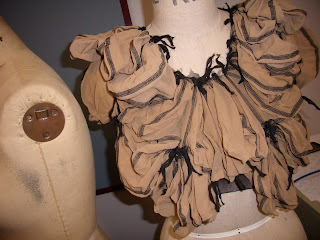Tuesday, June 8, 2010
week thirteen: how to lace your corset...
Monday, June 7, 2010
week twelve: persistent circles...

Sunday, June 6, 2010
week twelve: 'piecing it together'...





Saturday, June 5, 2010
week eleven: pantyhose...




Monday, May 31, 2010
week ten: sculpting...

week ten: corsetry...
The most common and well-known use of corsets is to slim the body and make it conform to a fashionable silhouette. For women this most frequently emphasizes a curvy figure, by reducing the waist, and thereby exaggerating the bust and hips. A shorter kind of corset, which covers the waist area (from low on the ribs to just above the hips), is called a waist cincher. A waist cincher (sometimes referred to as a Waspie) is a belt worn around the waist to make the wearer's waist physically smaller, to create the illusion of being smaller.
A corset has the influence to command the awareness of those around. It highlights the centre, the core of the skeletons frame. It protects the cluster of importance within the body, becoming a supportive armor. The chosen shape of a corset determines its power over the body. It most classically creates the hourglass figure desired by females, accentuating aspects of the form as to better shape. It ultimately crafts a smooth, reduced waistline which contours are rounded off to the hips.

Monday, May 17, 2010
week nine: dolls...

Human beings and their cultures have perennially focused attention on the female body as a source of aesthetic pleasure, sexual attraction, fertility, and reproduction. The female body occurs in a range of shapes. The female figure is typically narrower at the waist than at the bust and hips, and usually has one of four basic shapes: banana, pear, apple or hourglass. The bust, waist, and hips are called inflection points, and the ratios of their circumferences define these basic shapes. Usually, the bust area will depend on the person's weight and height.
Alteration of the body shape
Various strategies are sometimes employed to temporarily or permanently alter the shape of a body. At times artificial devices are used or surgery is employed. Breast size can be artificially increased or decreased. Breast Prostheses or padded Bras may be used to increase the apparent size of a woman's breasts, while minimiser bras may be used to reduce the apparent size.
Historically, the greatest efforts have been made to reduce a woman's waist line. Boned corsets were used for several centuries, but during the twentieth century these were mostly replaced with more flexible foundation garments. Where corsets are used for waist reduction, it may be temporary reduction by occasional use or permanent reduction by people who are often referred to as tightlacers. Liposuction is the common surgical method of reducing the waist size.
Padded control briefs or hip and buttock padding may be used to increase the apparent size of hips and buttocks. Buttock augmentation surgery may be used to increase the size of hips and buttocks and to make them more rounded.
Women simply aspire to amplify and intensify their natural physic to craft the ideal body. I intend to simply emphasis its form by honoring its imperative fundamentals. This will be carried out through the arrangement of colour and fabrication to mold and highlight features.